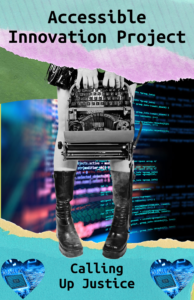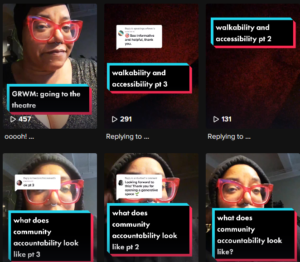Accessible Innovation Project:
Calling Up Justice using Artificial Intelligence to Increase Inclusion for Disabled Creators

Calling Up Justice is a company that is conducting an exciting project aimed at experimenting with accessibility and machine learning technology to increase empowerment for disabled creators. The project involved selecting a video or other writing source featuring disabled creators sharing their clever ideas for 1-3 minutes. Free platforms were then used to transcribe the video, which was subsequently fed into Chat GPT to produce an essay that authentically reflected the creators’ voices and ideas. With the help of Claudia Alick’s fine tuning data and prompts, the resulting essays were representative of the disabled creators’ perspectives. This project exemplifies how artificial intelligence technology can be leveraged to empower marginalized communities and create a more inclusive society, with minimal effort on the part of the creators. The following article was built off a series of tiktok videos published by Luticha Doucette.
From Walkable to Wheelchair-Accessible
by Luticha Doucette (produced by Claudia Alick via Chat-GPT)
Hey y’all, it’s Luticha Doucette here. I want to dive a little deeper into the topic of making cities more accessible and inclusive for everyone, especially those with disabilities. As the owner of Catalyst Consulting Associates, I specialize in active transportation projects for cities and municipalities.
The design of many cities, with wide roadways and high traffic speeds, can make it difficult for people with mobility issues, such as blindness, to cross the streets safely. To address this, we push for narrower roads, which not only improve accessibility for people with disabilities but also make the streets safer for everyone.
In Rochester, our bus system has partnered with Uber to create an Uber-like service for disabled people, making paratransit more accessible to those living in the suburbs. However, there is still a need for a multi-tiered paratransit system that is not income-dependent, as poverty can be a barrier for disabled individuals.
Improving bus routes is another crucial step towards making cities more accessible. Many cities are adopting the bus train model, which provides a dedicated lane for buses to travel in, separate from pedestrians and cars. This system offers door-to-door service, making it more convenient for disabled individuals.
It’s also essential to bring services like grocery stores, doctor’s offices, and other essential services closer to neighborhoods. From my research, I found that many disabled people have a travel radius of less than a quarter-mile from where they live, so bringing these services closer to them would increase accessibility.
However, there are still many challenges to overcome. Many cities lack an ADA Transition Plan or a competent ADA coordinator, and training dollars for this role are scarce. This means that there is a lack of training and knowledge in how to create ADA Transition Plans, which is crucial for making cities more accessible.
Improving walkability in cities is not just about infrastructure; it’s also about understanding the history of redlining and disinvestment that has contributed to the challenges we face today. We need to prioritize accessible parking and widen sidewalks to create better right of way for all individuals.
As a consultant, I understand the complexities of creating accessible and inclusive cities. It’s not just about improving infrastructure but also about educating individuals and creating policies that prioritize accessibility and inclusivity. Let’s work together to make our cities more accessible and inclusive for everyone.
Walkable City 1
@freedomofmovement #stitch with @crutches_and_spice #walkablecities #accessibility #disabilitytiktok
♬ original sound – freedomofmovement
Walkable City 2
@freedomofmovement Replying to @freedomofmovement #accessibility #walkablecities #disabilitytiktok #inclusion
♬ original sound – freedomofmovement
Walkable City 3
@freedomofmovement Replying to @speakingsunflower #inclusion #walkablecities #disabilitytiktok #accessibility #disabilityjustice #socialjustice
♬ original sound – freedomofmovement

